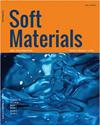二硫化四甲基秋兰姆与硫酸铜协同作用引发金属配位交联丁腈橡胶的研究
IF 1.4
4区 材料科学
Q4 MATERIALS SCIENCE, MULTIDISCIPLINARY
引用次数: 0
摘要
摘要在本工作中,我们描述了一种简单的方法,通过简单的混合和热压制备了一种新型的填充有硫酸铜(CuSO4)和四甲基秋兰姆二硫化物(TMTD)的丁腈橡胶(NBR)。对固化特性分析、聚合物链段的运动性能、物理性能、微观形貌、溶胀性能和动力学特性进行了全面探讨。结果表明,腈基与铜离子之间的金属配位相互作用使三维网络交联。硫化曲线、拉伸强度和交联密度随着TMTD在NBR/CuSO4化合物中的加入而显著增加,这是由于TMTD热解产生的Cu2+和Me2NCSn•(n=1–2)自由基之间的协同作用,导致超活性化合物[Cu(SnCNMe2)]•2+的形成,并显著促进-CN与Cu2+之间的配位交联。NBR/CuSO4/TMTD硫化胶因其优异的物理性能在实际应用中发挥着至关重要的作用。本文章由计算机程序翻译,如有差异,请以英文原文为准。
Investigation on metal coordination crosslinking nitrile butadiene rubber induced by the synergistic effect between tetramethylthiuram disulfide and cupric sulfate
ABSTRACT In this work, we described a simple method to manufacture a novel nitrile butadiene rubber (NBR) filled with cupric sulfate (CuSO4) and tetramethylthiuram disulfide (TMTD) via simple mixing and heat pressing. Cure characteristics analysis, the motion capability of polymer segments, physical properties, micromorphology, swelling properties and dynamic characteristics were explored comprehensively. The results demonstrated that the three-dimensional network was cross-linked by the metal coordination interactions between the nitrile group and copper ion. The cure curve, tensile strength and crosslinking density exhibited a considerable increasing with the addition of TMTD in NBR/CuSO4 compounds, which was due to the synergistic effect between Cu2+ and Me2NCSn• (n = 1–2) radicals generated by the pyrolysis of TMTD, resulting in the formation of the hyperactive compounds [Cu(SnCNMe2)]•2+ and promoting the coordination crosslinking between -CN and Cu2+ significantly. The NBR/CuSO4/TMTD vulcanizates induced by the synergistic effect would play a crucial role in practical application for the excellent physical properties.
求助全文
通过发布文献求助,成功后即可免费获取论文全文。
去求助
来源期刊

Soft Materials
工程技术-材料科学:综合
CiteScore
2.90
自引率
0.00%
发文量
21
审稿时长
2.2 months
期刊介绍:
Providing a common forum for all soft matter scientists, Soft Materials covers theory, simulation, and experimental research in this rapidly expanding and interdisciplinary field. As soft materials are often at the heart of modern technologies, soft matter science has implications and applications in many areas ranging from biology to engineering.
Unlike many journals which focus primarily on individual classes of materials or particular applications, Soft Materials draw on all physical, chemical, materials science, and biological aspects of soft matter. Featured topics include polymers, biomacromolecules, colloids, membranes, Langmuir-Blodgett films, liquid crystals, granular matter, soft interfaces, complex fluids, surfactants, gels, nanomaterials, self-organization, supramolecular science, molecular recognition, soft glasses, amphiphiles, foams, and active matter.
Truly international in scope, Soft Materials contains original research, invited reviews, in-depth technical tutorials, and book reviews.
 求助内容:
求助内容: 应助结果提醒方式:
应助结果提醒方式:


